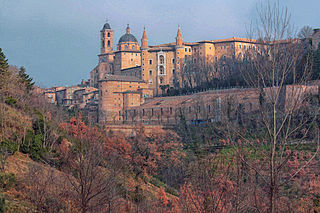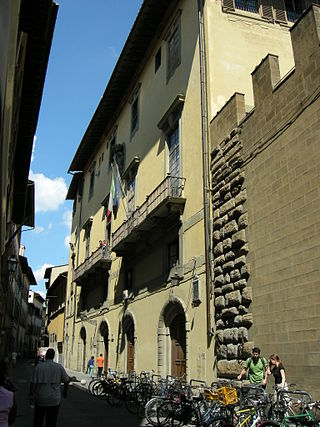
Urbino is a walled city in the Marche region of Italy, south-west of Pesaro, a World Heritage Site notable for a remarkable historical legacy of independent Renaissance culture, especially under the patronage of Federico da Montefeltro, duke of Urbino from 1444 to 1482. The town, nestled on a high sloping hillside, retains much of its picturesque medieval aspect. It hosts the University of Urbino, founded in 1506, and is the seat of the Archbishop of Urbino. Its best-known architectural piece is the Palazzo Ducale, rebuilt by Luciano Laurana.

Fano[ˈfaːno] is a town and comune of the province of Pesaro and Urbino in the Marche region of Italy. It is a beach resort 12 kilometres southeast of Pesaro, located where the Via Flaminia reaches the Adriatic Sea. It is the third city in the region by population after Ancona and Pesaro.

Pesaro is a city and comune in the Italian region of Marche, capital of the Province of Pesaro e Urbino, on the Adriatic Sea. According to the 2011 census, its population was 95,011, making it the second most populous city in the Marche, after Ancona. Pesaro was dubbed the "Cycling City" by the Italian environmentalist association Legambiente in recognition of its extensive network of bicycle paths and promotion of cycling. It is also known as "City of Music", for it is the birthplace of the composer Gioacchino Rossini. In 2015 the Italian Government applied for Pesaro to be declared a "Creative City" in UNESCO's World Heritage Sites. In 2017 Pesaro received the European City of Sport award together with Aosta, Cagliari and Vicenza.

The House of Malatesta was an Italian family that ruled over Rimini from 1295 until 1500, as well as other lands and towns in Romagna and holding high positions in the government of cities in present day Tuscany, Lombardy and Marche. The dynasty is considered among the most important and influential of the Late Middle Ages. In the period of maximum influence, they extended their domains along the Marche coast, up to Ascoli Piceno, Senigallia, Sansepolcro and Citerna, and to the north, on the territories of Bergamo and Brescia.

Simone Cantarini or Simone da Pesaro, called il Pesarese was an Italian painter and etcher. He is mainly known for his history paintings and portraits executed in an original style, which united aspects of Bolognese classicism with a bold naturalism.

The Biblioteca Nazionale Vittorio Emanuele III is a national library of Italy. It occupies the eastern wing of the 18th-century Palazzo Reale in Naples, at 1 Piazza del Plebiscito, and has entrances from piazza Trieste e Trento. It is funded and organised by the Direzione Generale per i Beni Librari and the Ministero per i Beni e le Attività Culturali.
Olivieri is a surname of Italian and Corsican origins. The name refers to:

The Biblioteca Riccardiana is an Italian public library under the aegis of the Ministry of Culture, located inside the Palazzo Medici Riccardi at 10 Via de’ Ginori in Florence, in the neighborhood comprising the Mercato Centrale and the Basilica di San Lorenzo. Its main feature is preserving books collected by members of the Riccardi family and making them available in the very same rooms that were originally dedicated to that purpose. So, still today the library boasts the magnificent bookshelves, neatly carved and gilded, that create the atmosphere of a late-seventeenth-century patrician library, whose main features have all been kept intact.

The Biblioteca Estense, was the family library of the marquis and dukes of Este. The exact date of the library's birth is still under speculation, however it is known for certain that the library was in use during the fourteenth century. Whilst it was greatly enriched during the Renaissance years in Ferrara, the library was concretely established in Modena in the beginning of the seventeenth century. It is known as one of the most important libraries in Italy. The library is located, along with the Galleria Estense directly below its collection of artworks, in the Palazzo dei Musei in Modena.

The Biblioteca Palatina or Palatina Library was established in 1761 in the city of Parma by Philip Bourbon, Duke of Parma. It is one of the cultural institutions located in the Palazzo della Pilotta complex in the center of Parma. The Palatina Library was named after Apollus Palatinus.

The Conservatorio Statale di Musica "Gioachino Rossini" is a music conservatory in Pesaro, Italy. Founded in 1869 with a legacy from the composer Gioachino Rossini, the conservatory officially opened in 1882 with 67 students and was then known as the Liceo musicale Rossini. By 2010 it had an enrollment of approximately 850 students studying for higher diplomas in singing, instrumental performance, composition, musicology, choral conducting, jazz or electronic music. The conservatory also trains music teachers for secondary schools and holds regular master classes. Its seat is the 18th century Palazzo Olivieri–Machirelli on the Piazza Oliveri in Pesaro. Amongst its past Directors are the composers Carlo Pedrotti, Pietro Mascagni, Riccardo Zandonai and Franco Alfano. Mascagni's opera Zanetto had its world premiere at the conservatory in 1896.

The Biblioteca Nazionale Braidense or Braidense National Library, usually known as the Biblioteca di Brera, is a public library in Milan, in northern Italy. It is one of the largest libraries in Italy. Initially it contained large historical and scientific collections before it was charged with the legal deposit of all publications from Milan. Since 1880, it has had the status of a national library and is today one of the 47 Italian State libraries.

The Marucelliana Library or Biblioteca Marucelliana, is a public library, founded by the mid-18th century, and located on Via Camillo Cavour # 43, in Florence, region of Tuscany, Italy.
San Giovanni Battista is a church located on Via Passeri #98 in central Pesaro, region of Marche, Italy.
Annibale degli Abati Olivieri was an Italian archaeologist, numismatist and librarian, considered the founder of the Biblioteca Oliveriana, Pesaro. An aristocrat without heirs, he was the author of works of archeology and numismatics. He also discovered the site of a Roman sacred grove, the Lucus Pisaurensis at his property on Collina di Calibano in the countryside of Pesaro, at which he unearthed the 13 Votive Stones of Pesaro.
The Ancient Votive Stones of Pesaro are 13 sandstone rocks that were unearthed in 1737 in a Pesaro, Italy farm field owned by Patrician Annibale degli Abati Olivieri. Oliverio dug up the stones at the site of his newly discovered Lucus Pisaurensis Sacred Grove on his property at Il Pignocco in Pesaro.
Lucus Pisaurensis is a sacred grove or lucus of ancient Pisaureum, modern Pesaro in Italy. It is just outside the coastal comune of Pesaro, between the Colle della Salute and the Collina in Santa Veneranda. It is in the Pesaro e Urbino Province of Marche, a pre-Imperium Romanum region of the Sabines and Latins peoples.

The Biblioteca Civica Romolo Spezioli or Biblioteca Civica di Fermo is a public library located on the Piazza del Popolo in the town center of Fermo, region of Marche, Italy.

Museo Oliveriano is an archaeology museum in Pesaro, region of the Marche, Italy.

The Biblioteca Civica Bertoliana is a main public library of the municipality of Vicenza, Italy. Inaugurated at the dawn of the 18th-century, and now the third largest library in the Veneto, after the Biblioteca Marciana of Venice and the University of Padua library. The main office is located in the Palazzo San Giacomo, Vicenza.
















